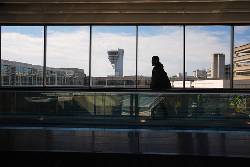Airports in New York, Los Angeles and Chicago are among 40 of the busiest across the U.S. where flights will be cut starting Friday due to the government shutdown, according to a list distributed to the airlines and obtained by The Associated Press.
The Federal Aviation Administration announced Wednesday it would reduce air traffic by 10% across “high-volume” markets to maintain travel safety as air traffic controllers go unpaid and exhibit signs of strain during the shutdown.
The affected airports in more than two dozen states include the busiest ones across the U.S., including Atlanta, Denver, Dallas, Orlando, Miami, and San Francisco. In some of the biggest cities — such as New York, Houston and Chicago — multiple airports will be affected.
The FAA is imposing the flight reductions to relieve pressure on air traffic controllers who are working without pay during the government shutdown and have been increasingly calling off work. The move also comes as the Trump administration is ramping up pressure on Democrats in Congress to end the shutdown.
Controllers already have missed one full paycheck and are scheduled to again receive nothing next week as the shutdown drags on.
The FAA has been delaying flights at times when airports or its other facilities are short on controllers.
Airlines shuffling schedules
Passengers should start to be notified about cancellations Thursday. Airlines said they would try to minimize the impact on customers, some of whom will see weekend travel plans disrupted with little notice.
United Airlines said it would focus the cuts on smaller regional routes that use smaller planes. United, Delta Air Lines and American Airlines said they would offer refunds to passengers who opt not to fly, even if they purchased tickets that aren’t normally refundable.
The head of Frontier Airlines recommended that travelers buy backup tickets with another airline to avoid being stranded.
The cuts could affect as many as 1,800 flights, or upwards of 268,000 passengers, per day, according to an estimate by aviation analytics firm Cirium.
Airlines routinely cut thousands of flights when a major snowstorm moves across the country in the wintertime. Last January, more than 2,000 flights were cancelled on one day as a storm moved across Texas, Louisiana and much of the Gulf coast.
The difference is that these cuts being made during the shutdown will last indefinitely until safety data improves.
“I’m not aware in my 35-year history in the aviation market where we’ve had a situation where we’re taking these kinds of measures,” FAA administrator Bryan Bedford said Wednesday. “We’re in new territory in terms of government shutdowns.”
Air traffic controllers have been working unpaid since the shutdown began Oct. 1. Most work mandatory overtime six days a week, leaving little time for side jobs to help cover bills and other expenses unless they call out.
Shutdown already straining airlines
Mounting staffing pressures are forcing the agency to act, Bedford said.
“We can’t ignore it,” he said.
Bedford and Transportation Secretary Sean Duffy said Wednesday that they would meet with airline executives to figure out how to safely implement the reductions.
Major airlines, aviation unions and the broader travel industry have been urging Congress to end the shutdown, which on Wednesday became the longest on record.
The shutdown is putting unnecessary strain on the system and “forcing difficult operational decisions that disrupt travel and damage confidence in the U.S. air travel experience," said U.S. Travel Association President and CEO Geoff Freeman in a statement.
Duffy warned earlier this week that there could be chaos in the skies if the shutdown drags on long enough for air traffic controllers to miss their second full paycheck next week.
He said some controllers can get by missing one paycheck, but not two or more.
Controller staffing worsening
Staffing can run short both in regional control centers that manage multiple airports and in individual airport towers, but they don’t always lead to flight disruptions. Throughout October, flight delays caused by staffing problems had been largely isolated and temporary.
But the past weekend brought some of the worst staffing issues since the start of the shutdown.
From Friday to Sunday evening, at least 39 air traffic control facilities reported potential staffing limits, according to an Associated Press analysis of operations plans shared through the Air Traffic Control System Command Center system. The figure, which is likely an undercount, is well above the average for weekends before the shutdown.
___
Associated Press journalist Christopher L. Keller contributed from Albuquerque, New Mexico.
...


 Copyright © 1996 - 2025 CoreComm Internet Services, Inc. All Rights Reserved. | View our
Copyright © 1996 - 2025 CoreComm Internet Services, Inc. All Rights Reserved. | View our